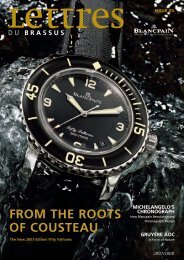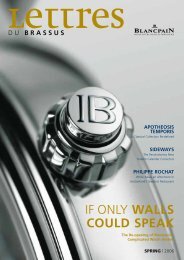THE HISTORY OF BLANCPAIN
THE HISTORY OF BLANCPAIN
THE HISTORY OF BLANCPAIN
Create successful ePaper yourself
Turn your PDF publications into a flip-book with our unique Google optimized e-Paper software.
pocket watches feature the crown at 12<br />
EM o’clock IPSUM with DOLOR small seconds SIT in line AMET, at 6 o’clock CONSE<br />
– during this time at Blancpain, winding,<br />
TUER however, ADIPISCING was done with ELIT, a key). SED He DIAMNO<br />
was a<br />
production innovator, as well, introducing<br />
MMY series NIBH methods EUISMOD in the workshop. TINCIDUNT<br />
Sadly the war had taken a toll on Frédéric-<br />
LAORET Louis who, DOLORE for reasons MAGNA of failing health, ALIQUA.<br />
was<br />
forced in 1830 to turn over the business to his<br />
son, Frédéric-Emile, but 19 years old. Demarking<br />
the change in generations, Frédéric-<br />
Emile dropped the name Frédéric from the<br />
business, adopting the moniker Fabrique<br />
d’horlogerie Emile Blancpain. Benefiting from<br />
the experience of his father, who despite his<br />
health worked alongside his son for 13 more<br />
years, Emile achieved remarkable success,<br />
building the business into the largest and<br />
most prosperous in Villeret. Not only did he<br />
introduce the lever escapement – the design<br />
used today in almost all mechanical Swiss<br />
watches – and stake out a speciality in<br />
women’s watches which was to distinguish<br />
Blancpain for more than a century, Emile<br />
made enormous strides in the production<br />
methods. He increased output from the<br />
workshops fully tenfold by development of a<br />
modern assembly line, which divided tasks of<br />
the watchmakers into particular elements of<br />
the watches. There is somewhat of an irony in<br />
this advance by Emile, since 150 years later,<br />
the modern Blancpain retreated to the traditions<br />
of the past well pre-dating Emile and<br />
distinguished itself from the rest of the indus-<br />
try in its rejection of production line methods,<br />
favouring instead hand assembly of watches<br />
from beginning to end by a single watchmaker,<br />
or as modern Blancpain terms it “an<br />
individual watchmaker working on a watch<br />
from A to Z”.<br />
Not only was Emile prolific as a watchmaker,<br />
he was prolific as a father. His five<br />
sons and three daughters all followed in his<br />
footsteps as horlogers. Upon his untimely<br />
death in 1857 at the age of 46, three of his<br />
sons, Jules-Emile, Nestor and Paul-Alcide,<br />
took the reins of the Blancpain enterprise.<br />
Later, in 1865, Jules-Emile and Paul-<br />
Alcide, fully preserving the business, reincorporated<br />
together. They were to preside<br />
over a period of enormous technical change<br />
and competitive pressure. On the technical<br />
side, winding by means of a key fell to the<br />
wayside, replaced by the more modern<br />
method of keyless works enabling both<br />
winding and time setting by means of the<br />
crown. But it was the brutality of the business<br />
environment that raised the sternest<br />
challenges. In 1860 the average price of a<br />
silver men’s watch with a cylinder escapement<br />
was 50 francs; in the ensuing 40 years<br />
that price was to fall by a factor of 5 to but<br />
10 francs. Even though it is certain that this<br />
observation will elicit no sympathy whatsoever<br />
from anyone remotely connected with<br />
today’s electronics industry where prices for<br />
storage or computing power may fall a hundred<br />
fold in but five years, this price collapse<br />
JULES-EMILE <strong>BLANCPAIN</strong>. FREDERIC-EMILE XY <strong>BLANCPAIN</strong> <strong>BLANCPAIN</strong>.<br />
08<br />
| 09<br />
took its toll on Villeret’s watch industry. Of<br />
the 20 companies which existed when Jules-<br />
Emile and Paul-Alcide Blancpain took over<br />
the business, only three others apart from<br />
Blancpain were to survive through to the<br />
very early 1900s.<br />
Blancpain’s formula for prospering during<br />
this washout of the industry was Jules-Emile’s<br />
decision to specialise in high end watches<br />
featuring lever escapements. Following the<br />
departure of his brother Paul-Alcide, who left<br />
to pursue a career of all things brewing beer<br />
in Fribourg, Jules-Emile, now joined by his<br />
son, Frédéric-Emile (not to be confused by his<br />
grandfather who bore the same name), continued<br />
the pursuit of modernity. Directly in<br />
front of the original Jehan-Jacques farmhouse,<br />
Blancpain constructed a new twostorey<br />
factory which for the first time employed<br />
water power from the bordering Suze<br />
river to generate electricity.<br />
Frédéric-Emile Blancpain’s career was to<br />
endure until 1932. For his later years, he was<br />
joined in 1915 by Betty Fiechter who assisted<br />
in running the business. Over the period<br />
1915-1928, Frédéric-Emile trained Betty,<br />
allowing her to become the director of the<br />
factory overseeing all of the production for<br />
Blancpain. Revealing of his embrace of technology<br />
and his progressive approach to management,<br />
was Frédéric-Emile’s use of the<br />
then remarkable invention, the Dictaphone.<br />
Preferring to spend his time in Lausanne<br />
rather than Villeret, he was given to dictat-







